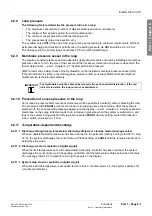
Technical description
Part 1 • Page 5-1
Part 1 – Operating Instructions
Rev. 4.00 December 2014
Software version 1.04
EcoRO Dia I/II (HT)
Part 1 • Chapt
er 5
5.
Technical description
The
Aquaboss
®
EcoRO Dia I/II (HT) provides the operator with a geared to consumption reverse osmosis
system. A 4-line LCD plain text display allows all operating parameters to be called up and monitored at
any time.
A special flushing and disinfection program developed for compact systems with the integrated
Aquaboss
®
impulse back washing system ensures maximum dialysis water hygiene.
An innovative logical control system makes high water yield possible even under unfavourable raw water
conditions. In this respect, the raw water consumption depends solely on the purest water requirement of
the end operator.
A menu-guided plain text display enables the operator to monitor all production parameters and system
functions including the disinfection mode in an individual and reproducible way.
Special advantages
•
Operator-friendly operation thanks to the menu-guided control system with plain text display
•
Low water consumption including rinsing water for
Aquaboss
®
softener and standstill rinsing
•
Shut-down and standstill rinsing with leakage monitoring during standby mode
•
Membrane blockage protection using
Aquaboss
®
impulse back washing
•
Optional impulse shear force rinsing
•
Durable stainless steel design
•
Mains separation / unhindered input in accordance with national safety standards
•
Option: Hot sanitation of the 1st and 2nd membrane stage (only for EcoRO Dia I/II (HT))
5.1
How it works
The treatment of water (for requirement see
part 2, chapter 7) by a reverse osmosis system results
in purified water (permeate) which is characterized by very low values for the chemicals within the water.
The separation rate of the undesired chemical contents is over 95%!
The permeate quality for water for diluting haemodialysis concentrates is defined Standard
AAMI/ANSI/ISO 23500:2011 (see
The EcoRO Dia I/II (HT) works on the reverse osmosis principle. Reverse osmosis describes a process
involving a pressure-operated cross-filtration system. The water flows under high pressure (up to max.
22 bar / 319 psi) tangentially over a semi-permeable membrane. As is the case with normal filtration, the
system is cleaned by allowing one component (water) of the mixture to be separated to pass through the
membrane with almost no hindrance, while the other components (dissolved and undissolved water con-
tents) are held back to a greater or lesser extent and leave the filtration unit in the concentrate flow. This is
a purely physical separation process in the molecular range which does not change the components being
separated either chemically, biologically or thermally.
A polyamide membrane (nonporous polymer membrane) is used. The material transport through such
a membrane type can be described in high accordance with experimental results on the basis of the
solution diffusion model. This model views the polymer membrane as a real fluid in which the permeands
dissolve and are diffusively transported along the gradient of their propelling force.
















































